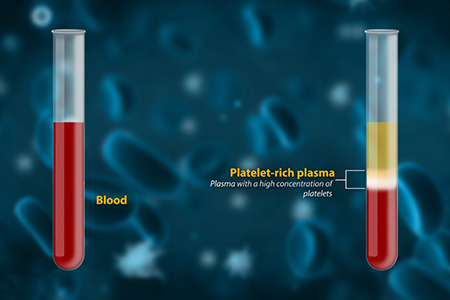What is ACP Max PRP?
 ACP Max PRP (Autologous Conditioned Plasma Max Platelet-Rich Plasma) is an advanced form of PRP therapy designed to provide enhanced healing for various musculoskeletal injuries and conditions. Developed by Arthrex, this system involves processing a patient's blood to yield a highly concentrated plasma containing platelets, growth factors, and anti-inflammatory proteins, and reinjecting this enriched plasma back into specific areas of injury or degeneration. The "Max" designation indicates a higher concentration of platelets and bioactive proteins, which aim to accelerate healing by stimulating tissue repair, reducing inflammation, and enhancing recovery times.
ACP Max PRP (Autologous Conditioned Plasma Max Platelet-Rich Plasma) is an advanced form of PRP therapy designed to provide enhanced healing for various musculoskeletal injuries and conditions. Developed by Arthrex, this system involves processing a patient's blood to yield a highly concentrated plasma containing platelets, growth factors, and anti-inflammatory proteins, and reinjecting this enriched plasma back into specific areas of injury or degeneration. The "Max" designation indicates a higher concentration of platelets and bioactive proteins, which aim to accelerate healing by stimulating tissue repair, reducing inflammation, and enhancing recovery times.
Indications for ACP Max PRP
ACP Max PRP is usually recommended for individuals who want to avoid surgery or have not responded well to other treatments. It is commonly used in orthopedics, sports medicine, and even dermatology to treat a wide range of conditions, including:
- Arthritis
- Bursitis
- Muscle injuries
- Tendonitis
- Ligament sprains
- Joint pain
- Skin rejuvenation
This therapy can also be utilized to accelerate and improve the healing process and decrease the risk of infection after surgery. It has been utilized to supplement ACL surgeries, rotator cuff repairs, joint replacement surgeries, and Achilles repairs.
Contraindications for ACP Max PRP
You may not be a good candidate for ACP Max PRP if you have:
- An active infection
- Unstable angina
- Cancer
- Blood disorders such as severe hypovolemia (low blood volume), anemia (low red blood cells or hemoglobin), and thrombocytopenia (low blood platelet count)
Preparation for ACP Max PRP
In general, preparation for ACP Max PRP treatment may involve the following steps:
- A review of your medical history, including medications or supplements you are taking, any allergies, blood work, or underlying health conditions
- Discontinue medications and supplements that can increase bleeding risk, such as aspirin, as well as supplements like fish oil, vitamin E, or ginkgo biloba for about two weeks before the treatment
- Discontinue anti-inflammatory medications, such as ibuprofen and naproxen for about two weeks before and after the treatment
- Drink plenty of water before the procedure as good hydration ensures optimal blood volume, which can improve the quality of the PRP collected
- Eat a healthy diet rich in vitamins and minerals as it can support your body’s healing processes
How Does ACP Max PRP Procedure Work?
The ACP Max PRP procedure is a straightforward, minimally invasive process that focuses on drawing, processing, and reinjecting a concentrated solution of platelets to support tissue healing. Here is a general outline of how it works:
- A small sample of the patient’s blood (usually 10-15 mL) is drawn from a vein, similar to a standard blood test.
- The blood sample is placed into the ACP Max dual-chamber syringe, which is designed to safely separate and concentrate the platelets. The sample is then processed using a centrifuge, which spins the blood to isolate the platelet-rich plasma (PRP) from other components, particularly reducing white blood cells to avoid excess inflammation.
- After centrifugation, the syringe contains the concentrated PRP solution with a high number of platelets and growth factors. This ACP Max PRP solution is then prepared for injection.
- Under guidance (often ultrasound), the physician injects the PRP directly into the injured or affected area, such as a joint, tendon, or muscle. Ultrasound guidance ensures precise placement for optimal results.
Outcomes
Since ACP Max PRP is designed to deliver a higher concentration of platelets and growth factors, it can potentially provide faster and more robust healing responses compared to standard PRP. As the concentrated platelets release growth factors, they stimulate cell regeneration, reduce inflammation, and improve tissue repair. Many patients experience gradual improvement over a few weeks to months, with pain reduction and enhanced function in the treated area. Some patients may need additional injections depending on their condition and healing response for the best outcomes.
Post-Procedure Care
After the ACP Max PRP injection, patients are typically advised to rest the treated area for a short period. Patients may experience mild swelling or discomfort in the injection area due to the PRP activating the body’s natural healing response, which naturally subsides after a few hours of rest. Patients receive instructions for aftercare, which may include avoiding anti-inflammatory medications and strenuous/heavy lifting activity for a few days to allow the PRP to work effectively. You may gradually return to normal activities as advised. Follow-up appointments may be scheduled to assess progress.
Benefits of ACP Max PRP Treatment
The ACP Max PRP system offers several benefits, especially in the realm of regenerative medicine and orthopedics. These include:
- Accelerated healing
- Accelerated recovery
- Improved regeneration
- Reduction of pain, swelling, and inflammation
- Reduced need for surgery
- Improved quality of life
Risk and Side Effects of ACP Max PRP Treatment
The ACP Max PRP procedure is minimally invasive and generally well-tolerated, with few risks and side effects because it uses the patient's own blood. These side effects may include:
- Pain and discomfort
- Redness and swelling
- Possible nerve damage
- Blood clot formation
- Bruising or bleeding




